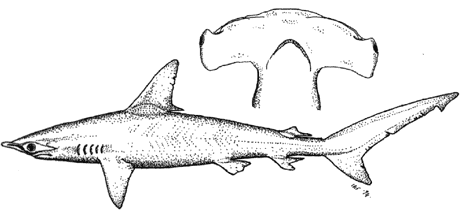Smooth hammerhead (Sphyrna zygaena)

(Linnaeus, 1758)
| Fr |
Requin-marteau |
| Sp |
Cornuda cruz; Tiburon martillo; Martell
(Catalunya); Cornuda (Menorca); Cornailla
(Llevant) |
| It |
Squalo martello; Pisci crozza (Catania);
Pescio scrossua (Liguria); Pesce carabiniere (Salerno);
Magnosa (Puglia) |
| Ma |
Kurazza komuni; pixximartell
|
Diagnosis
A large (to over 300 cm) hammerhead shark with a broadly convex
head measuring 26 to 29% of TL; its anterior margin arched and
smooth, without any median indentations. Tooth count
(excluding small symphyseal tooth if present) 13-15 in each side of
the upper jaw, 12 to 14 in lower jaw; teeth usually finely serrated.
First dorsal fin moderately tall, measuring 12 to 15.4% of TL, with
an acutely rounded apex and rather falcate in shape; its origin
opposite the pectoral insertions and with its free rear tip not
extending rearwards to above the pelvic fin origins. Posterior
margins of pelvic fins essentially straight or very slightly
concave. Second dorsal fin small and low, smaller than the anal fin
height with its posterior margin roughly twice the fin height; free
rear tip long but not extending to the precaudal pit. Pectoral fins
moderate in size, their anterior edges equating to 15.4 - 18.0% of
TL; their posterior margins only slightly falcate. Dorsal colour
dark olive brown-grey, fading gradually to white ventrally. Ventral
apices of pectoral fins dusky.
Size
Attains 370cm and possibly greater; mostly to 300cm; size at
birth 50 to 60 cm.
Status and Distribution
Mediterranean Sea: Occasional; localised abundance
apparently declining in some areas and may be in decline regionally.
The most frequently-encountered hammerhead in the region.
Cosmopolitan through the Mediterranean, from Gibraltar to the
Bosphorus and Sea of Mamara but not the Black Sea; can be locally
abundant at times, especially juveniles (e.g., within the Gulf of
Tunis); only sporadically caught in recent years from some more
northern areas such as the Ligurian Sea and upper reaches of the
Adriatic; more frequent in the Aegean, especially the eastern
(Turkish) side and Dodecanese Islands.
Biology
An active coastal and semi-oceanic pelagic shark of temperate and
sometimes tropical waters, often occuring very close inshore
including within small bays, estuaries and near tidal flats; ranging
from the intertidal to depths of at least 50 metres based on diver
sightings off Gozo, Malta; juveniles typically close inshore,
particularly within sheltered, shallow bays and gulfs. These sharks
may occur singly or in small groups; juveniles may be locally
abundant and form large schools. Occasionally these sharks (both
juveniles and adults) are seen swimming slowly at the surface, with
dorsal fin exposed, especially in hot mid-summer weather.
Principaly piscivorous, they feed upon a wide variety of bony fish
including clupeids and small scombrids, sea bass, mullet and
flatfishes; also elasmobranchs including smaller sharks and
especially batoids (stingrays); invertebrate prey includes
especially cephalopods and some benthic crustaceans.
They will readily scavenge from surface longlines and nets and have
been encountered doing so at substantial distances offshore within
the southern reaches of the Sicilian Channel.
Reproduction is viviparous, with litters of 29 to 50 young after a
gestation period of 10 to 11 months. Parturition occurs within the
Sicilian Channel and doubtless elsewhere in the region, apparently
in the summer months with neonatal specimens occurring locally
inchore through July, August and September. Females mature at about
265cm and males at 210 to 250cm.
The Shark Trust, 36 Kingfisher Court, Hambridge Road, Newbury, Berkshire, RG14 5SJ, UK.
Tel(+44) 01635 551150, Fax(+44) 01635
550230
|